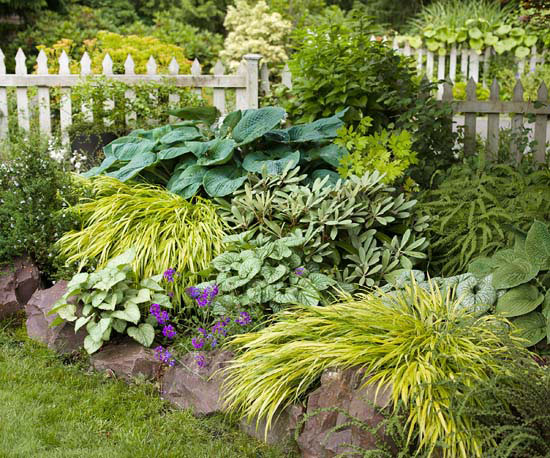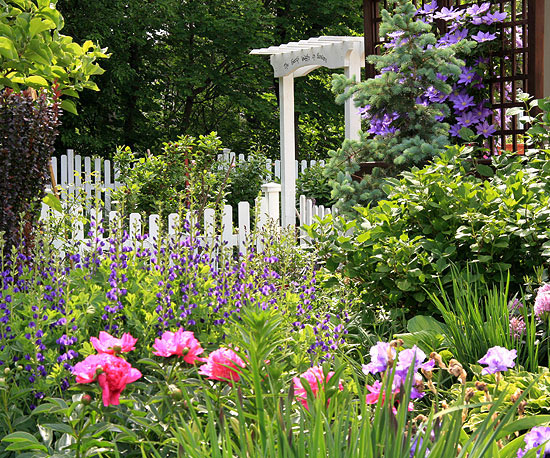





We all lead busy lives -- school, work, sports, hobbies, housekeeping -- the list at times seems endless. When it comes to landscaping, many homeowners don't have time to fiddle with fussy plants or deadhead endless blooms. There are ways, however, to design and maintain diverse, beautiful outdoor spaces without sacrificing countless free hours. Try these six easy landscaping maintenance tips.
continue reading below
Before you rip out plants and redo borders, ask yourself: How much time do you want to spend with your yard, and how much are you willing to invest in others working in your landscape? "Maintenance should really be brought up at the beginning and limits on time or dollars should be discussed," says Walt Cudnohufsky, owner of landscape architecture firm Walter Cudnohufsky Associates in Ashfield, Massachussetts.
For example, if you choose to do the work yourself, you might prioritize easy-care plants that reach maturity and fill in a landscape with minimal maintenance. Or if you don't enjoy yardwork and have a little extra money to spend, you can pay for others to do some tasks, which means you might be able to include plants that are more labor-intensive. "Low maintenance means different things to different people," Cudnohufsky says.
Cudnohufsky says clients often ask for a no-maintenance landscape, a notion he's quick to dispel. "That doesn't exist. Whenever you have plants, there's going to be effort involved," he says. "It's a misperception about nature."
Find even more tips to cut your landscape maintenance time.

Most good, easy-care landscape designs, Cudnohufsky says, have two elements: a theme and variation. Pick the wrong theme, and you can wind up with a labor-intensive landscape you didn't count on. Concentrate on just plant variation, and the time-consuming effort of taking care of lots of different types of flowers can be an encumbrance. "Far too often people only go for variation and the showy parts of plants," he says.
Cudnohufsky suggests something simpler: Build your flowerbeds and borders with drifts of similar plants that are stunning but require the same type of maintenance. "Then you can use just a few accent plants by season to bring even more interest to the garden," he says.
For most home gardeners, the landscape is about plants, but good hardscaping also contributes to the ease of maintenance. Do your homework and research the durability and maintenance requirements of materials, from decking to pathways to edging. Materials' ability to withstand your climate's extremes should play into the selection process.

It may seem counterintuitive, but regular chores can make taking care of a landscape easier, Cudnohufsky says. For example, a tree that's pruned every few years won't have dead branches that could fall during a storm and wreak havoc on a yard. A weekly once-around to pluck a few weeds can yield time-saving dividends, too. "We all get lax in things that aren't screaming at us," Cudnohufsky says. "But if you are slow on the trigger and have an invasive weed and let it go, it can take over in just a few weeks. Regular visits can help you pace and measure your time commitment."
Cudnohufsky often sees homeowners doing tasks that require a lot of time (and in some cases money) but don't pay off, such as fertilizing too much or dumping a mulch volcano around a tree. "There's a lot of maintenance that goes toward the wrong things," he says.
Another misunderstanding Cudnohufsky often encounters: Plants never change. "Plants grow. They need to be pruned, thinned, divided," he says. "There's this sense that plants have been there forever and have never changed, that landscapes are more stable than they really are."
Of course, any landscape involves a balancing act between how plants look when they're planted and how they'll look when fully grown. But patience, as well as a location that will accommodate the full growth of a plant, is good maintenance advice. "Plants are never overgrown, just unwisely placed. A garden goes through stages, and your maintenance can ebb and flow," Cudnohufsky says. "You can also simplify if plants are requiring too much maintenance. For example, groundcovers usually have higher maintenance at the beginning of their lives and then less when grown."
Simplify, simplify, simplify: That's Cudnohufsky's advice. If you don't really need an edging material, don't use it; it's one more thing to maintain. If you can curve something instead of setting it at an angle, do so. "Extra materials and joints and edges are where a lot of maintenance time goes," Cudnohufsky says. "If in doubt, leave it out, because all those things add to the complexity. Don't try to solve a problem with another material that takes too much attention."
Copyright © www.100flowers.win Botanic Garden All Rights Reserved